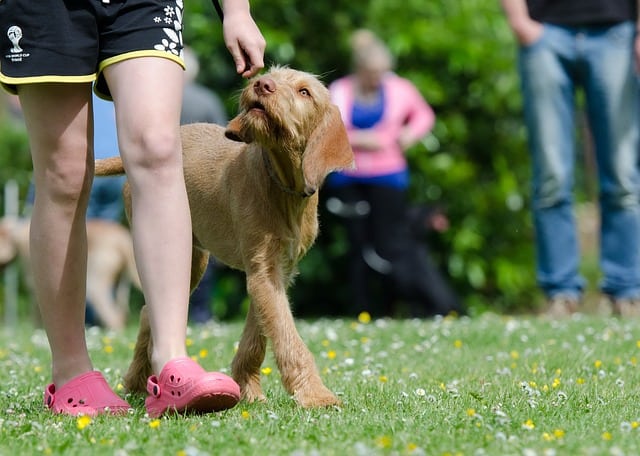How To Start Dog Training With The Right Approach

There are some affiliate links below, but they are all products I highly recommend. For more info, view my disclosure here.
Are you thinking about getting a puppy, or you have a new dog? Whether you’re a first-time dog owner or just looking for advice on where to begin to better train your new pup, this guide is for you!
We’ll review the best approach to start training your dog, along with helpful resources to guide you through it all. Whether you and your dog are just starting out or you’re looking for ways to improve your dog’s training and build your bond, read on for the core values to help you have a happy, well-trained dog!
Start With The Basics
As a pet owner, I’m sure you’ve heard of dog training, but it’s hard to know where to even begin or who to trust. Dog training can be a daunting task, but when you keep some core values in mind, it becomes much simpler for both you and your dog.
The Core Values of Dog Training
Training methods that stick to these essential core values will help owners and their well-trained dogs build a happy relationship. If these values are not followed, however, the training methods will not be effective and may even backfire.
To be successful with your dog, you must first realize that training is not just about training the dog; it’s about training the owner. Dogs do not come pre-programmed to work on their own; they require patience, consistency, and clear communication from their owners in order to learn.
Patience Is The Most Important Aspect of Dog Training
Training a dog requires a lot of patience because dogs learn through trial and error. They don’t instinctively *know* what words mean which task they’re supposed to do, so it’s up to us to understand that and be patient.
This process may feel tedious at first, but behaviors that are positively reinforced with calmness will tend to repeat over time, whereas behaviors that are not, will tend to reduce and eventually disappear.
Communication Is Key When Dog Training
It’s important to communicate with your dog in a clear and concise manner when training him. Make sure that all of your commands are voiced clearly and that you use simple words that your dog can understand.
When training dogs, it’s also important to avoid punishing or scolding them; this will only frustrate them and may lead to disobedience.
Consistency Is SO Important To Dog Training
One of the most important aspects of training is consistency. If your commands are given consistently, your dog will eventually learn to associate them with a desired behavior. However, if you vary your tone of voice or the way you deliver your commands, your dog will not be able to understand what it is that you want him to do.
If you are not consistent with your commands and follow-through, your dog will become confused. Dogs thrive on knowing what is expected of them and what will happen when they do or do not obey a command.
For example, if you tell your dog to sit and he does so, give him lots of praise and reward him with a treat. If you tell your dog to sit and he does not obey, do not give him a treat or pet him. You want to reward those positive behaviors!
Dogs know black and white but fail to understand gray lines. If your dog is not allowed on the couch and then, just this one day, you feel like he should be invited just because it is cold and you want to snuggle up, he will think the rules have changed, and won’t understand why he’s suddenly not allowed up there the next time.
It is very important to be consistent; you can’t ask a dog to walk politely one day and then let them drag you along the next, just because you are in a rush and it is raining and you don’t have time.
Make sure as well that all family members are on the same page when it comes to training. If the plan is for your dog not to beg at the table, watch for your children dropping unwanted bits of food under the table as an accidental positive reinforcement in your dog’s eyes!
Be Very Clear When Dog Training
Dogs thrive on clear rules and it is important to make it clear when they do something right and do something wrong. At times, dog owners use tones of voice that are very similar when they are telling the dog he did a good job or he did wrong.
It is important to make it clear as day and night what tone of voice and marker is given for a good job and what tone of voice and marker is used to tell the dog he got it wrong.
A simple, gentle “oops” or “nope” helps communicate without being overly negative and scaring or frustrating your dog. Also, attention must be given to commands; ensure all your family uses the same command for the same expected task.
Countless families use “down” interchangeably for getting the dog off the couch, stopping from jumping, and laying down. Can you imagine how confusing that must be?

Tips For Housetraining Your Dog
First and foremost, let’s start with housebreaking your dog. This is probably the most important aspect of good dog training because it establishes a basic relationship between you and your dog.
If your dog has regular accidents in your home, it becomes harder to break them of it. That makes it especially important to nail this first!
When we first rescued Rico, he was a mess! He was found in a box on the side of the road, and had been there for awhile. He didn’t have that natural instinct to not potty where he slept, so he would just go wherever he was. We would sit outside for hours trying to encourage him to potty, only for him to come back in and immediately go.
Even worse, he did what we used to call “the fire hydrant” where he’d run around while playing with Roxy and would just pee everywhere while running! It was such a mess! It’s a good thing he’s cute and he did make it out of that phase, luckily!
Housetraining is such a huge topic that it deserves a post devoted to it. Here’s the total guide to house train your dog the easy way!

Handling Obedience Training and Basic Commands
Following up on housebreaking is obedience training – this is where your pup learns specific skills, how to behave properly in public and around other people’s dogs.
The world of dog training seems to be split in two at times with, on one side, those who feel it is essential for their dogs and, on the other hand, those who believe dogs can live without it.
Truth is, most of the time those who train their dogs are often blessed with a stronger bond as training sets a foundation of mutual trust and respect.
Dog training is key to having a happy, well-behaved dog. However, finding the right approach to dog training for you and your dog can be difficult.
- Make a plan. Planning is key when it comes to training a dog. Make sure you have a clear idea of what you want to achieve and what steps you need to take to get there.
- Set realistic goals. Don’t try to train your dog overnight – it will frustrate both of you. Set smaller, manageable goals that you can achieve over time and build up on those positive behaviors.
- Be consistent. It’s important to be consistent with your training methods, and to provide the same type of environment and rewards every time.
- Be patient. Training a dog is not a quick process, and it will take time and patience to get results.
- Use positive reinforcement. Often times, the most effective way to train a dog is by using positive reinforcement. This means rewarding your dog when he or she behaves in a desired manner.
- Avoid punishment. punishment is not only ineffective, but it can also be harmful to a dog’s psyche. Instead, use positive reinforcement to train your dog.
The following are some general tips that will help you get started on your dog training journey:
-Start with basic obedience commands such as sit, stay, come, and down. These commands will lay the foundation for other more advanced behaviors. Here’s a handy guide on 8 commands every dog should know.
-Ensure you provide enough physical and mental stimulation for your dog through regular walks, playtime, and training sessions.
-Correct bad behaviors immediately using a clear, calm tone of voice and be consistent.
With the outdated dominance theory on its way out and a better understanding of how dogs learn and interact with humans, it is clear that old methods of attempting to “force the dog into submission” to obtain an obedient dog are more harmful and can backfire.
As dog training methods are more researched, most are thankfully no longer pushing “dominant” or “alpha” style training and are leaning towards engaging in behaviors that are positively reinforced. It is up to us as dog parents to help them make good choices by rewarding the behaviors we want.
These core values, along with a dog’s eagerness to please, ultimately make training happen. Set your dog up for success and reap the rewards of having a dog that is a pleasure to be around by investing some time in training.
Kikopup is widely regarded as one of the best Youtube channels for dog training. There’s even an entire playlist just for puppy training that’s super helpful.
You don’t need to commit to large blocks of time, as that can overtire both you and your dog. Instead, just a few minutes each day will often suffice to keep the dog’s mind stimulated and happy and receptive to training.






